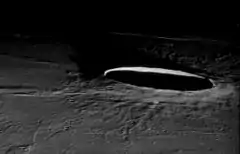Reiner (crater)
Reiner is a lunar impact crater on the Oceanus Procellarum, in the western part of the Moon. It has a nearly circular rim, but appears oval in shape due to foreshortening. The rim edge is well-defined and has not been eroded by impacts. In the midpoint of the irregular crater floor is a central peak. Outside the rim is a hummocky rampart that extends out across the mare for about half a crater diameter.
 Lunar Orbiter 4 image | |
| Coordinates | 7.0°N 54.9°W |
|---|---|
| Diameter | 30 km |
| Depth | 2.6 km |
| Colongitude | 55° at sunrise |
| Eponym | Vincentio Reinieri |


To the west-northwest of the crater on the Oceanus Procellarum is the unusual feature Reiner Gamma, a fish-shaped surface marking of ray-like material with a high albedo.
Reiner is a crater of Eratosthenian age.[1] It is named after the astronomer Vincentio Reinieri, a disciple of Galileo Galilei.
Satellite craters
By convention these features are identified on lunar maps by placing the letter on the side of the crater midpoint that is closest to Reiner.
| Reiner | Latitude | Longitude | Diameter |
|---|---|---|---|
| A | 5.2° N | 51.4° W | 10 km |
| C | 3.5° N | 51.5° W | 7 km |
| E | 1.9° N | 49.6° W | 4 km |
| G | 3.3° N | 54.3° W | 3 km |
| H | 9.1° N | 54.7° W | 8 km |
| K | 8.1° N | 53.9° W | 3 km |
| L | 8.0° N | 54.6° W | 6 km |
| M | 8.6° N | 56.1° W | 3 km |
| N | 5.4° N | 57.5° W | 4 km |
| Q | 1.4° N | 50.9° W | 3 km |
| R | 3.7° N | 55.5° W | 45 km |
| S | 2.2° N | 50.7° W | 4 km |
| T | 3.7° N | 52.2° W | 2 km |
| U | 4.1° N | 52.5° W | 3 km |
References
- The geologic history of the Moon. USGS Professional Paper 1348. By Don E. Wilhelms, John F. McCauley, and Newell J. Trask. U.S. Government Printing Office, Washington: 1987. Table 12.2.
- Andersson, L. E.; Whitaker, E. A. (1982). NASA Catalogue of Lunar Nomenclature. NASA RP-1097.
- Blue, Jennifer (July 25, 2007). "Gazetteer of Planetary Nomenclature". USGS. Retrieved 2007-08-05.
- Bussey, B.; Spudis, P. (2004). The Clementine Atlas of the Moon. New York: Cambridge University Press. ISBN 978-0-521-81528-4.
- Cocks, Elijah E.; Cocks, Josiah C. (1995). Who's Who on the Moon: A Biographical Dictionary of Lunar Nomenclature. Tudor Publishers. ISBN 978-0-936389-27-1.
- McDowell, Jonathan (July 15, 2007). "Lunar Nomenclature". Jonathan's Space Report. Retrieved 2007-10-24.
- Menzel, D. H.; Minnaert, M.; Levin, B.; Dollfus, A.; Bell, B. (1971). "Report on Lunar Nomenclature by the Working Group of Commission 17 of the IAU". Space Science Reviews. 12 (2): 136–186. Bibcode:1971SSRv...12..136M. doi:10.1007/BF00171763. S2CID 122125855.
- Moore, Patrick (2001). On the Moon. Sterling Publishing Co. ISBN 978-0-304-35469-6.
- Price, Fred W. (1988). The Moon Observer's Handbook. Cambridge University Press. ISBN 978-0-521-33500-3.
- Rükl, Antonín (1990). Atlas of the Moon. Kalmbach Books. ISBN 978-0-913135-17-4.
- Webb, Rev. T. W. (1962). Celestial Objects for Common Telescopes (6th revised ed.). Dover. ISBN 978-0-486-20917-3.
- Whitaker, Ewen A. (1999). Mapping and Naming the Moon. Cambridge University Press. ISBN 978-0-521-62248-6.
- Wlasuk, Peter T. (2000). Observing the Moon. Springer. ISBN 978-1-85233-193-1.